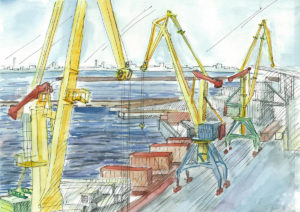1. The history of the forms of contract (background, the purpose of their development, structure, specifics). 2. Types of FIDIC contracts. 3. When is the application of FIDIC forms of contract rational? 4. Misbelieves about the FIDIC forms of contract. 5. Specifics of the Kazakh laws in the application of the FIDICforms of contract.
1. The history of the forms of contract (background and the purpose of their development).
FIDIC, the abbreviation, translated from the French language as the International Federation of Consulting Engineers (further «FIDIC»), was established in 1913.
In the mid of the last century there was marked the global upward trend in construction projects funded by international and interstate banks and associations.
The size of such projects implied the allocation of considerable funds for their implementation, the long periods, and the large liability both from the technical and financial points of view.
In the standard approach to the project implementation (the contract between the customer and the contractor), it was very difficult for the funding institutions to control the quality of the facilities under construction, the expenditure of funds allocated, and the progress of the project itself. In addition, the customers were often not skilled in some areas of construction.
In the 60s of the last century, at the insistence of international banks, it was decided to always and in mandatory manner attract to such projects an independent third party which would be a professional in the needed area, would supervise the construction process from the technical point of view, being neither the customer nor the contractor, as well as to deliver to the banks sufficient information to evaluate possible risks during the project implementation.
Exactly for this purpose, FIDIC was engaged to develop the first FIDIC forms of contracts. By request of banks, the forms of contracts for construction were developed; in them, special focus was made to the Client’s (Employer’s) Representative (referred to in some books as the "Engineer"). It's kind of a technical controller which acts as a representative of the Client (Employer) on the construction site, takes important technical solutions, controls payments, checks and monitors the quality and order of works, and etc. The representative of the Client (Employer) can be either an individual, or a company.
It is important not to confuse the Client’s (Employer’s) Representative with Technical Supervision, the latter of that kind as we are used to perceive it in Kazakhstan.
Looking ahead, we can say that the funding organization often imposes a particular Engineer on the Client (Employer), but it does so only because it has experience of working with this Engineer.
In the development of the forms of contract, special attention was given to the parity of rights and obligations of the Client (Employer) and the Contractor, as well as the focusing on the special role and functions of the Client’s (Employer’s) Representative.
The FIDIC forms of contract are initially a very formal and expensive construction process, in terms of administration, designed to implement large-scale, capital-intensive and long-term projects.
In the mid of 1980s the forms of contract appeared which covered not just the construction of facilities, but the construction on a turn-key basis, the construction with the accompanying supply of equipment and engineering works, as well as the forms of contract for services between the Client (Employer) and the Client’s (Employer’s) Representative.
Structure and composition of forms of contract are usually similar to each other and consist of the following main elements:
- Offer
- Acceptance
- Contract
- General Terms and Conditions
- Special (particular) conditions
- Annexes and charts
It is also important to note that the text in the FIDIC forms of contract covers many details and almost all issues that may arise during the construction process. Basically, the reason for covering so many details is the application of these forms of contract in the English law. For example: examination, preparation and transfer of the construction site; obligations on the mobilization and keeping in order of access roads; risk insurance for the facility and works; actions in case of discovery of treasures, and other.
The below specifics can be called the most important distinguishing features of the FIDIC forms of contract:
- General Conditions of the contract do not alter, remaining the same as they are in the forms of contract. Regarding some items of the contract (eg Item 5.1 "Language and the Governing Law" and Item 70.1 "Increase or Decrease in the Value" of the Red Book), FIDIC Federation directly states about the necessity to include additional text in the Special Conditions so that the Terms and Conditions of the Contract will be complete. Other articles may require the inclusion of additional text in order to supplement the General Conditions or provide for special circumstances or types of works (eg, dredging operations), and the peculiarities of local legislation;
- A separate section of the contract provides for the creation of a commission to deal with disputes and arbitration (sometimes, the Engineer solely is vested with the powers of an arbitrator), the procedure for its convocation, actions and decision-making;
- A different approach to the definition of force majeure (if accidents constantly occur on the construction site, the Contractor shall be ready for them; if it became known about the impending circumstance, the Contractor shall take all possible measures with regard to this, and so on);
- Due to the fact that the basis for the forms of contract is the English law, the concepts such as liquidated damages and other are applied in the text.
2. Types of FIDIC contracts
The following forms of contracts, which were developed by FIDIC and are most commonly used today, are: Conditions of Contract for Works in Civil Engineering Construction" ("Red Book"). These are recommended for the construction or engineering works designed by the client (employer) or its representative, or Engineer. Under an ordinary contract of such type, the contractor carries out all work in accordance with the project developed by the client (employer). However, the scope of work may include engineering and infrastructure operations, mechanical, electrical and/or construction works designed by the contractor.
The "Short Red Book", which is based on the standard "Red Book" - Conditions of Contract for Works in Civil Engineering Construction", must be noted separately. It is recommended for construction and engineering works with the relatively small amount of investment. Depending on the type of work and the circumstances, this instrument can be also applicable for contracts with large amounts of investment for relatively simple, repetitive, or of short-term works. In the framework of an ordinary contract of this type, the Contractor will perform all work in accordance with the project of the Client (Employer) or its representative (if any). This form can be also acceptable to the contract, which includes, or which content can contain, the performance of engineering and infrastructure operations, electromechanical and/or construction works designed by the contractor.
"Conditions of Subcontract for Works in Civil Engineering Construction" ("Green book"). These are recommended for engaging of subcontractors by general contractors, whose main scope of work is described in the FIDIC forms of contracts.
"Client / Consultant Model Services Agreement" ("White Book"). The agreement is solely for the consulting. It is important not to use this form of contract, for example, for design, as the Yellow Book is specially provided for design. "Conditions of Contract for Design-Build and Turnkey" ("Orange Book"). These can be applied in the construction on a turn-key basis of fully equipped and ready to operate plant, power station, infrastructure facility or other similar facility, where, in the first place, the accuracy of estimate of the final cost of the facility and the timing of the project implementation are important, and, in the second place, the contractor bears full liability for the project development and the carrying out of all works, all this with the minimum involvement of the client (employer).
Conditions of contract for Electrical and Mechanical Works "("Yellow Book"). These can be recommended for supply and installation of electrical and/or mechanical equipment, as well as in the development of project and the carrying out of construction or engineering operations. Under an ordinary contract of this type, the contractor develops the project and, in accordance with the client’s (employer’s) requirements, carries out installation of equipment and/or other types of work, which may include any combination of engineering and infrastructure works, mechanical, electrical and/or construction operations.
Condition for Contract for EPC Turnkey, First Edition 1999 (“Silver book”). These are recommended not only for EPC projects performed as part of larger projects such as "Build-Operate-Transfer" (BOT) or similar, but for other projects (eg projects for the implementation of electrical works and the installation of mechanical equipment, as well as other projects involving the supply and installation of process equipment, implemented in various countries by various clients (employers), including the projects carried out by the ministries or private developers, which the client’s (employer’s) expect their performance on a turnkey basis at a fixed price by a single contractor). Under an ordinary contract of this type, the contractor performs design, supplies and all kinds of construction and engineering operations, delivering on a turnkey basis the fully equipped facility ready for operation.
The said forms of contracts are recommended for universal application in the conducting of international bids. In some countries these forms of contracts can be altered as per the laws of these countries, especially if these forms of contracts are applied for contracts between residents. FIDIC regards the original forms of contract in the English language as official and authentic ones. Developing the forms of contract is not the final purpose for FIDIC. On the website www.fidic.org one can find guidelines on the above-mentioned books, the forms for conducting bids, and the articles of FIDIC members.
3. When is the application of FIDIC forms of contract rational?
First of all, we should proceed from the purposes these forms of contracts were developed for. The application of these forms of contract is simply necessary, when it comes to public money or funds of international intergovernmental institutions. Separately, we can distinguish large interstate industrial holding companies, for which the application of FIDIC forms of contracts in some cases is advantageous (see below). Frankly speaking, because of the relatively high cost of administration of the FIDIC forms of contract as one of the reasons, their application for the construction projects with the value of less than U.S.D. million is not recommended (in particular, the Construction Contract as for the Red Book). As for the Silver Book (construction on a turnkey basis), these are the projects worth more than one hundred million U.S. dollars.
Some exceptions have begun appearing recently. For example, they are recommended to be applied with regard to the Green Book (subcontract) or the Yellow Book (design, electromechanical operations and repairs) only for the contracts with the value of more than U.S.D. 1 million.
The application of the Silver Book (construction on a turnkey basis, as well as the primary operation of the facility to achieve certain performance) is convenient for large holding companies in their entering new markets (which is sometimes a risky process complicated with corruption or a lack of well-operating legal system). In the context of such a contract, the scope of contractor’s liability is much bigger than the scope of the client’s (employer’s) powers to directly control the construction. This allows the contractor to have more self-reliance (followed by some reservations), and the client (employer) not to constantly focus on the operational control of construction and finally to get a ready and functioning facility producing products in accordance with the parameters specified in the bidding documents. The issue of the final cost of the project is not taken into account here. The most common practice in Kazakhstan is the application of the Red Books (construction contract) and Silver Books (turnkey construction, sometimes called EPC contracts - engineering, procurement, construction). In particular, the examples are:
- Construction of the road Western Europe – Western China. The Ministry of Transport and Communications of Kazakhstan enters into contracts of construction and maintenance on a turnkey basis (Silver Book);
- Construction by developers on the basis of the Red Books (construction contract) of a complex of residential and non-residential building in Almaty.
All these projects have one common thing – the contractors and engineers of these projects are large foreign construction companies from Italy, Turkey, Iran, England, etc., ie professionals who have experience of construction in other countries on the basis of FIDIC forms of contracts.
FIDIC forms of contract are applied throughout the CIS. In Russia, ice rinks, Olympic villages and other particularly important and costly projects are being built for the Olympic Games 2014 in Sochi.
4. Misbelieves about the FIDIC forms of contract.
The following misbelieves I will list are marked by the entities that apply the FIDIC forms of contract exactly on the CIS territory. One of the most famous entities applying these in Russia is Konstantin B. Trumpel.
Many believe that the FIDIC forms of contract contradict to our laws and therefore cannot be applied in Kazakhstan. In the development of its forms of contract and their publication, FIDIC apparently stated that these forms of contract are some sort of "guidance for work," but not the final and only possible version for application. The structure of all the forms of contract contains "Special Conditions", which are necessary exactly to identify and take into account the peculiarities of the national laws. The forms of contract are always finalized by making amendments to them to bring them in line with the national laws of the country where they are applied.
FIDIC forms of contract were developed primarily for the developing countries in Africa and Southeast Asia, which are marked by the lack of construction law or the latter is just emerging. Moreover, the forms of contract were originally an Anglo-Saxon contract. That is why they are so detailed.
Recently in its recommendations FIDIC openly said that the parties should involve local specialists to adapt the texts of the FIDIC forms of contract to bring them in line with the national legislation (in particular, this was said in the recommendations for the White Book (contract for consulting services – attracting the Engineer) and others).
For the contractor, it is an enslaving deal.
The most of local experts, including experienced contractors, at the first reading of FIDIC forms of contract think so. However, in reality, FIDIC forms of contract have a big number of different mechanisms (eg - an increase in the contract value, prolongation of the term, etc.), allowing the contractor with the support from a competent consultant to gain many financial benefits.
In the development of its forms of contract, FIDIC did its best and they managed to make their forms of contract a balanced transaction where the interests of the client (employer) and the contractor are equally protected, in other words the «dealing on the fair terms».
No capability to work with the texts in the English language.
Official texts of FIDIC forms of contract are available mostly in the English language; some official forms of contract are also available in the French, German and other languages. To date, FIDIC forms of contract have had no official translation into Russian. Russian versions of FIDIC forms of contract, which are currently offered for sale on their website, are mostly a philological translation and interpretation rather than legal one. Official translation into the Russian language is a translation approved at the conference of Russian-speaking members of FIDIC.
However, in the post-Soviet space there is a number of translations made by various translators which are used successfully. Our company has also some translated documents. The parties decide on their own what language to use as the primary language in the application of FIDIC forms of contract and their further signing.
In our opinion, the authenticity of a text is a matter of professionalism of the consultants who run projects on the basis of the FIDIC forms of contract.
Too much paper documentation, reporting, and other things, it is impossible to work.
Indeed, any FIDIC form of contract involves a large number of reporting documents, correspondence and other paperwork. To successfully cope with all that for a non-trained professional is not a simple task. Exactly for this reason, it is right when the contracting parties are skilled professionals which have experience in FIDIC forms of contract. In fact, FIDIC forms of contract in a convenient manner systematize documentation, though not quite in the customary manner the national experts are used to. The reporting documentation that has been so got as a result of work on the FIDIC forms of contract allows to always clearly and precisely control the progress of work and its funding.
It is possible to resolve the issue of the future work with the documentation by involving a qualified consultant that has relevant experience in that. In addition, the correctly made documents at the stage of preparation of FIDIC forms of contract will reduce the time needed to fill in them and their use in the future. In practice, whole departments are involved in running the paperwork mentioned above. For this, special software, training courses and tutorials and etc. are available.
5. Specifics of the Kazakh laws in the application of FIDIC forms of contract
The texts of FIDIC forms of contract often contain terms and definitions, as well as mechanisms that do not fit into the realities of Kazakhstan legislation. They need to be governed by Special Conditions. Let us dwell on some of them:
- The structure of FIDIC forms of construction contracts suggests that the contract represents the text on one page, indicating a project name, the names of the parties and the agreement in principle of the Parties on implementation of some work. The scope of work, the name of the facility, term, total cost and payment procedure are specified in Annexes to the Contract. This approach is contrary to the laws of the Republic of Kazakhstan, since it is necessary to specify essential conditions of the contract in Contract itself. In this regard, it is necessary in a mandatory manner to cover all these essential conditions in the contract itself, not only in the Annexes.
- The term "Employees of the Client (Employer)" (construction contract in the Red Book): Engineer, assistants, other employees of the Engineer and the Client (Employer), as well as any staff, referred to in the notice as such by the Contractor or the Client’s (Employer’s) Engineer (General Conditions, Item 1.1.2.6). This term because of the incorrect translation is likely not to meet the Labor Code of Kazakhstan. FIDIC’s concept is that these are not only the employees who are the staffers of the Client (Employer), but also those engaged by the Client (Employer) as subcontractors.
- Transfer of a construction site to the Contractor (the Red, Orange, Silver Books, and other). As mandatory provision: The Client (Employer) is obliged to provide to the Contractor in possession a constriction site and the right of access to it for the period specified in the Annex to the Offer. Such right and possession can be given not only to the Contractor. With this, the mechanism of transferring the construction site is limited to the simple signing of the acceptance certificate. However, in practice, the availability of such acceptance certificate is not enough, and by virtue of our legislation, we recommend to transfer the construction site under a separate contract (eg the Trust Deed). The text of such Trust Deed shall be part of the bidding documents.
- As mandatory provision, the Contractor gets on its own all necessary permits and approvals. Additional obligations of the Client (Employer) should be mentioned separately: the Client (Employer) shall provide assistance to the Contractor (upon its request) in the obtaining of permits and approvals, also in the delivery of a notice to the authorized body as to the start of the construction (provided that the permit for construction has been obtained), and others.
- The fee to the Consultant under the White Book (the contract for consulting services between the Client (Employer) and the Engineer). As mandatory provision, the rates are not lump-sum, ie not fixed. For state-run companies and not only for them, this approach is not always acceptable. In this regard, the prices for the Services of the Consultant should be fixed, at least to limit them to the maximum possible amount.
- The start of design under the Orange Book (design and construction on a turnkey basis). The term "Commencement Date" has a reference to the provision that "The Contractor shall begin the design and construction of the Facilities in the shortest possible (technically feasible) time after....". In the context of this book "technically feasible" means not only in terms of readiness of a phase, but also in terms of availability of natural conditions (weather, etc.) for this. For instance, making measurements at a temperature of 30 degrees below zero at a certain wind velocity is only possible at height of 2 to 3 meters above ground, and all what is above this level, can be measured only after the weather gives such opportunity.
By Artyushenko Andrey Managing partner Artyushenko & Partners law firm
In Artyushenko & Partners online Store you can buy our fixed fee legal services:







